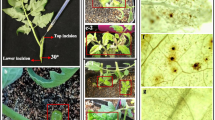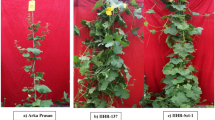Abstract
Tomato yellow leaf curl virus (TYLCV, genus Begomovirus, family Geminiviridae), poses a serious threat to tomato crops in tropical and subtropical regions. We developed a simple agroinoculation method with an infectious clone of TYLCV. Dipping of excised sections of susceptible tomato shoots in an Agrobacterium suspension successfully introduced the replicating virus with high efficiency. An additional vacuum treatment for 5 min ensured uniform infection without escapes, allowing evaluation of differences in TYLCV resistance among tomato cultivars. The method can be used in laboratory experiments for virological studies and in breeding programs for resistant cultivars.




Similar content being viewed by others
References
Al Abdallat AM, Al Debei HS, Asmar H, Misbeh S, Quraan A, Kvarnheden A (2010) An efficient in vitro-inoculation method for Tomato yellow leaf curl virus. Virol J 7:84
Czosnek H, Kheyr-Pour A, Gronenborn B, Remetz E, Zeidan M, Altman A, Rabinowitch HD, Vidavsky S, Kedar N, Gafni Y, Zamir D (1993) Replication of Tomato yellow leaf curl virus (TYLCV) DNA in agroinoculated leaf discs from selected tomato genotypes. Plant Mol Biol 22:995–1005
Edwards K, Johnstone C, Thompson C (1991) A simple and rapid method for the preparation of plant genomic DNA for PCR analysis. Nucleic Acids Res 19:1349
Lapidot M (2007) Screening for TYLCV-resistant plants using whitefly-mediated inoculation. In: Czosnek H (ed) Tomato yellow leaf curl disease. Management, molecular biology, breeding for resistance. Springer, Dordrecht, pp 329–342
Mansoor S, Briddon RW, Zafar Y, Stanley J (2003) Geminivirus disease complexes: an emerging threat. Trends Plant Sci 8:128–134
Moriones E, Navas-Castillo J (2000) Tomato yellow leaf curl virus, an emerging virus complex causing epidemics worldwide. Virus Res 71:123–134
Ohnishi J, Kitamura T, Terami F, Honda K (2009) A selective barrier in the midgut epithelial cell membrane of the nonvector whitefly Trialeurodes vaporariorum to Tomato yellow leaf curl virus uptake. J Gen Plant Pathol 75:131–139
Picó B, Ferriol M, Díez MJ, Viñals FN (2001) Agroinoculation methods to screen wild Lycopersicon for resistance to Tomato yellow leaf curl virus. J Plant Pathol 83:215–220
Ueda S, Kimura T, Onuki M, Hanada K, Iwanami T (2004) Three distinct groups of isolates of Tomato yellow leaf curl virus in Japan and construction of an infectious clone. J Gen Plant Pathol 70:232–238
Vidavski F, Czosnek H, Gazit S, Levy D, Lapidot M (2008) Pyramiding of genes conferring resistance to Tomato yellow leaf curl virus from different wild tomato species. Plant Breed 127:625–631
Acknowledgments
We thank Dr. Shigenori Ueda (NARO, KONARC, Japan) for providing the infectious clone pBSzY and useful suggestions on our study.
Author information
Authors and Affiliations
Corresponding author
Rights and permissions
About this article
Cite this article
Yamaguchi, H., Ohnishi, J., Miyatake, K. et al. A simple, efficient agroinoculation soaking procedure for Tomato yellow leaf curl virus . J Gen Plant Pathol 79, 243–248 (2013). https://doi.org/10.1007/s10327-013-0450-x
Received:
Accepted:
Published:
Issue Date:
DOI: https://doi.org/10.1007/s10327-013-0450-x




